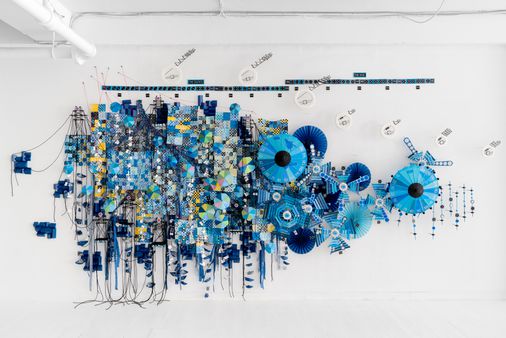
A guide to cyberarts: From bots to glitch, an annotated glossary for an age of augmented reality – The Boston Globe
“They learn faster that way,” said Fifield.

Reben uses algorithmic models from Artbreeder, an AI resource and social media site. The AI combines words such as “flower” and “dog,” produces images depicting the resulting nonsense words, and “breeds” two images. Reben looks at the spawn, and another AI program reads his brainwaves and body signals, determining which ones grab him. He sends those — familiar but monstrous, sometimes unnervingly creepy — to a painting workshop in China, where anonymous painters put them on canvas.
Algorithmic Art or Cyberarts: Catch-all phrases for art made using digital tools.
Augmented Reality: Geolocated virtual art viewed through a smartphone or tablet. In 2020, Nancy Baker Cahill’s AR public art project, “Liberty Bell,” appeared over Fort Point Channel in Boston and in other cities, evoking harmony, dissonance, and unraveling in that crucial election year.

AR made its first art-world splash in 2010, when artists Sander Veenhof and Mark Skwarek staged a guerrilla exhibition, “WeARinMoMA” at the Museum of Modern Art. During the 2020 COVID-19 lockdown, Cuseum, a Boston consulting company that enhances visitor experiences at cultural institutions, developed an app, [AR]T Museum, to sate the appetites of museum-starved viewers.
Bot Art: Algorithms producing artistic riffs on the Internet, like Katie Rose Pipkin and Loren Schmidt’s @mothgenerator on Twitter, which engineers new species for your visual delectation, such as the sweetpotato-columbia sheep moth.
Fifield once exhibited Caleb Larsen’s “A Tool to Deceive and Slaughter” at Boston Cyberarts Gallery. “It was literally just a black box. You had to plug it into power and the Internet, and it would perpetually try to sell itself on eBay,” Fifield said. “If it sold itself, a contract came with it. When it sold again, you had to pass it to the next person.”
Cryptoart: Artworks linked to non-fungible tokens, better known as NFTs — files coded to a blockchain, or digital ledger, which can’t be changed. An NFT is a piece of metadata that includes an image or link, the artist’s name, a date stamp, the buyer’s name, and a contract attached to a monetized token stored in the blockchain.
It’s like a deed that says you own the intangible artwork. The contractual system offers an opportunity for artists to receive commissions when a piece is resold, which usually isn’t the case with analog art. The virtual Museum of Crypto Art launched in 2018 and started collecting in 2020.
The market for cryptoart is hot. Christie’s auctioned its first NFT in March, by the digital artist Beeple, for more than $69 million. Commercial galleries, such as New York’s bitforms gallery, and Art Blocks, a gallery in Marfa, Texas, are capitalizing on this new way to commodify art.
Data Visualization Art: Information as source material. Boston artist Nathalie Miebach uses climate data and basket weaving techniques to craft sculptures that embody hard truths about the environment. “She takes big, complicated pieces of data and turns them into sculpture that you understand,” Fifield said.

Nathalie Miebach
In “Deconstructed Anthems,” data artist Ekene Ijeoma removes musical notes from performances of the “The Star Spangled Banner” at a rate based on that of mass incarceration in the United States.
Glitch Art: Throwing a wrench into the digital works. Glitch artists intentionally apply errors to image files. “It usually results in an interesting twisting of whatever you started with,” Fifield said. The duo bent/haus, now at Boston Cyberarts Gallery, features glitch artist Allison Tanenhaus’s geekily radiant abstractions in concert with analog works by artist Ben K. Foley.
Robotics: “People build interesting objects that interact with you physically in real space and real time,” said Fifield. In 2010, Alexander Reben’s master’s thesis at the MIT Media Lab was Boxie, a roving robot that got lost in the halls of MIT and rather adorably asked for help.
Fifield points to Harold Cohen as a progenitor of robot art.
“He was a successful painter in London in the 1950s, and then had a midlife crisis, moved to California and learned computer programming,” Fifield said.
In 1973, Cohen developed a program he called AARON, outfitting a robotic system with pen and ink.
“He gave AARON all the knowledge he had about drawing and painting.,” Fifield said. “As long as you kept it supplied with ink and paper, it would draw a brand-new drawing every time.”

A 21st-century AARON, Ai-Da, is a humanoid AI robot that draws, paints, and collaborates, developed in 2019 by British gallerist Aidan Meller and the robotics company Engineered Arts.
But are AARON and Ai-Da’s paintings art — or is the art the robot itself, which raises uncomfortable questions about what it is to be human? Art is in the eye of the beholder, and some tech wizardry verges in an artful direction — like Boston Dynamics’s cyberdog, Spot.
“Boston Dynamics has surprisingly done an amazing set of videos with their robots that approach robot art,” Fifield said. “They’re dancing to rock music. They do Mick Jagger, but as a robot.”
Virtual Reality: Immersion in a virtual space created by an artist with stereo imaging. A headset is required. VR art stars include the duo of Laurie Anderson and Hsin-Chien Huang, and Jon Rafman.
Rafman’s sumptuous and terrifying “View of Harbor,” developed by Studio Samuel Walker was in “Art in the Age of the Internet, 1989 to Today,” a 2018 exhibition at the Institute of Contemporary Art. Goggled viewers placed their hands on the ICA’s plate glass window to anchor them in real life as a virtual tsunami rose from Boston Harbor and engulfed them.
This content was originally published here.


